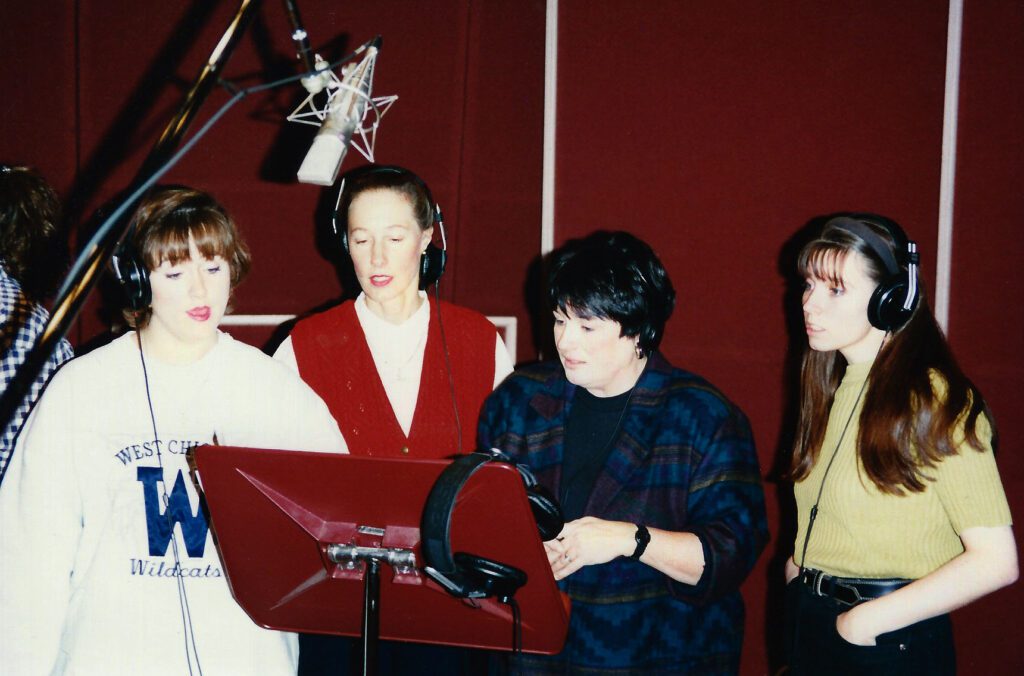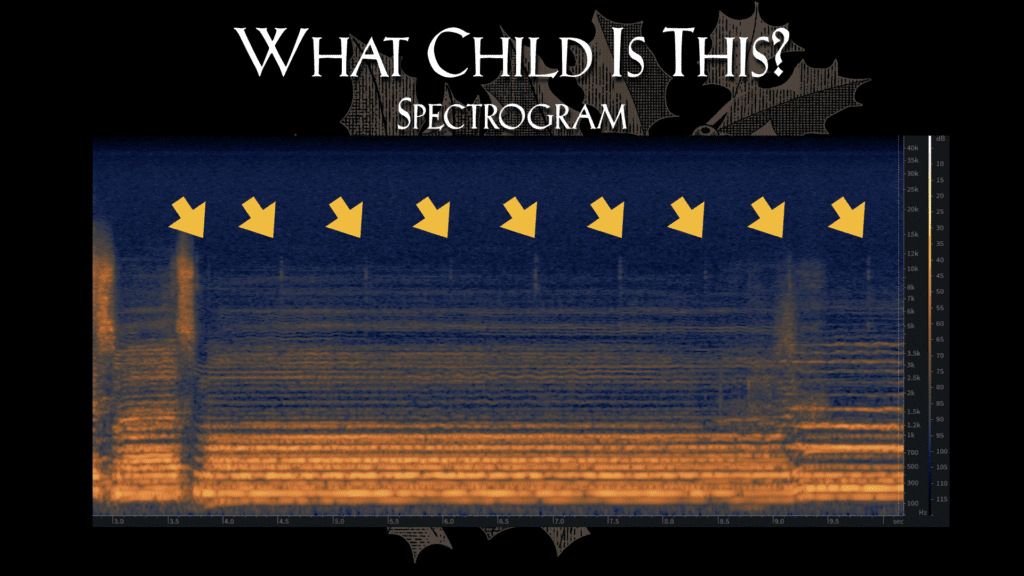A cool bit of audio cleanup that we are very, very proud of…
[blockquote]This is Part 7 of a series on the production of A Time Will Come For Singing (Special Edition). See All Posts[/blockquote]
Back in 1995, the St. Petronille Contemporary Choir decided to record Paul’s arrangement of “What Child Is This?”, a song we frequently performed during the Christmas season. Paul’s arrangement was intended to be completely a cappella — just voices, with no other instrumentation; that’s how we always performed it live. While the group could have recorded the song “freehand” in the studio, a cappella material is often recorded to a “click track” or other reference audio.
Why? There are a variety of reasons.
Frequently in the studio, a vocal ensemble will record their parts separately. In that case, as each additional vocal part is added, the singers need a common rhythm and pitch reference to make sure everyone is paddling in the same direction. During a live performance, often there is a conductor or at least some sort of a group leader who directs the group as to how fast to sing or when to cut off at the end of a line. The director can certainly do this in the studio on “Take 1”, but as soon as you decide to overlay additional singers on that first take, you have a problem. In the second session, the new group of singers can hear what was already recorded, but they can’t see the conductor’s directions when the first pass was recorded.
In terms of pitch, meanwhile, if your group is performing a concert with some kind of backing instruments — anything from a simple piano accompaniment to a full orchestra — you can be assured that the vocalists will generally stay in pitch all the way through the piece. The accompaniment gives the singers a pitch reference to follow as the performance goes on. But in a cappella music, since there’s no instrumentation, the singers are on their own when it comes to staying in tune and in the same key they started at. Many a cappella singers will tend to gradually drift off their starting key (usually downward) over time.
In order to avoid these sorts of pitch issues in the studio, singers often have a “scratch mix” in their headphones. This rough musical track, plus the click track, gives the singers the pitch and rhythm reference they need to keep everyone together as they’re recording.

That is, in fact, how “What Child” was recorded back in 1995. The singers were all wearing headphones, and they had a simple piano accompaniment and click track in their ears as they performed the tune. But recording an a cappella arrangement this way raised a very common phenomenon when recording using this method: headphone bleed.
Many singers like to hear themselves “through the air” when performing. You can hear your own voice through a process called bone induction, where your vocal chords cause vibrations in the bones of your head that are, in turn, picked up by the nerves in the ear. Everyone else hears your voice “through the air,” which sounds a little different. It’s why everyone thinks their voice sounds different “on tape” (spoiler alert: you’re the only one who thinks you sound different. Everyone else thinks you sound exactly the same.). Since the microphone hears you “through the air,” listening to your voice coming back through headphones can sound a little off. As a result, many singers like to pull one headphone off so they get a more natural sense of how they sound while recording.
In a normal vocals-and-instruments arrangement, this practice works just fine. A little bit of the sound of the reference track might leak out of the headphones and be picked up by the microphone. We call this “headphone bleed.” But once the final instruments are mixed into the track, any headphone bleed is completely masked and inaudible in the final mix.
In a cappella music, though, there’s a problem: there’s no instruments to mask the sound of the reference tracks leaking out of the headphones in the studio. Unless you’re really careful and keep the headphone levels way down, the sound of the click track or the instrumental scratch mix can find its way onto the final vocal tracks.
[blockquote]In a normal, vocals-and-instrument arrangement, pulling one headphone off to better hear yourself is not normally a problem. When recording an a cappella arrangement, it can be disastrous.[/blockquote]
And, in 1995, that is exactly what happened to Paul and company during the sessions for “What Child Is This.” Paul and Larry realized during mixing that the sound of the click track bled onto the vocal tracks, leaving a very distracting background in the mix that the audience was never supposed to hear.
In those days, there really wasn’t much you could do to remove headphone bleed from a final mix. You could always go back and try to re-record the affected tracks, but getting the singers back together and scheduling another session in the studio was an expensive, time-consuming option. For a project that had to be finished in time for Christmas, that option was quickly dismissed. Rather, Paul and Larry decided to mask the headphone bleed by adding some jingle bells and yet another sound from the Korg M-1 — in this case, a synthesized nylon string guitar sound. Here’s how the track sounded on the original album:
The extra instrumentation certainly served its intended purpose; you could not hear the scratch and click tracks in the final mix. But they added an extra layer of digital “varnish” to a song that shouldn’t have needed it; the choir never performed it that way live. Having that cheesy, dated sounding “band aid” on one of his arrangements always irked Paul over the years. It was one of the reasons he was always so resistant to the idea that A Time Will Come For Singing would ever be released online.
Back in March of last year, Paul and I talked about releasing a re-worked version of something from the album. He brought up this issue — that “What Child Is This?” should never have needed those goofy jingle bells and lame synth guitar. I quickly realized that while it may not have been possible to fix headphone bleed in 1995, doing so in 2018 is absolute child’s play with audio restoration tools like we have today.
[blockquote]Having a cheesy, dated sounding “band aid” on one of his arrangements was a big reason why Paul Sirvatka was always so resistant to the idea that A Time Will Come For Singing would ever be released online.[/blockquote]
One such tool that is an absolute must have in my audio restoration arsenal is Izotope RX. The software consists of a series of plugins each designed to tackle a particular audio problem — background hum, sibilance, wind noise, cell phone interference — you name it. But RX also includes a standalone app that gives you a spectral view of the audio file you’re working on, and the problem you’re trying to solve. Click track bleeding through the headphones appears in the audio spectrum as a periodic, rhythmic series of sharp points. Isotope is a little like Photoshop for audio in that regard — simply select each of the clicks in the spectrum, select “attenuate,” and the software does the rest. What was an embarrassing studio issue is completely and utterly gone in a matter of minutes.

Paul was pretty floored when I demonstrated this process to him. This was a moment when we began to believe we might be able to clean up and re-release the entire album — not just a song or two. And now, nearly 18 months after Paul got his first introduction to the power of 21st century audio restoration, we are thrilled to include “What Child Is This?” on our special edition as it was originally intended, and as we always performed it — completely a cappella. No cheesy synth instruments, no cheesy jingle bells — just the group’s vocals.
Here’s the same clip from “What Child Is This?”, as it will appear on the Special Edition:
Much better. Exactly as the choir intended it to be, even if it took 23 years to get there!
A Time Will Come For Singing will be available on CD and online in December. We hope you’ll pick up a copy!


